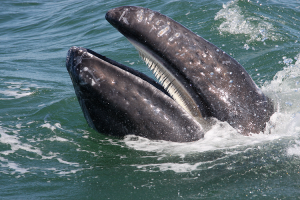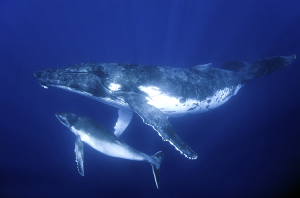A Whale-sized Hole in the Ocean Ecosystem
A study published in November 2021 reported more accurate measurements of just how much giant whales eat—and just how much they defecate (eliminate solid wastes)—which has surprising effects on the ocean ecosystem and even global climate. The research demonstrates that ocean food webs are more complex and intertwined in surprising ways, more surprising than simple predator-prey relationships.
Baleen whales, including the blue whale, bowhead whale, fin whale, and right whale, are among the largest animals that ever lived. These gigantic beasts feed mainly on millions of tiny shrimp-like krill and other zooplankton that they filter out from huge gulps of seawater. Calculating exactly how much they eat has always been a difficult exercise.

A gray whale filters food from water by squeezing the water out of its mouth through thin plates called baleen.
Credit: © Shutterstock
In the latest study, scientists used Global Positioning System (GPS) tags to follow more than 300 baleen whales as they swam and ate their way through the oceans. This tracking enabled the scientists to record each time a whale lunged to gulp a mouthful of krill. Sonar and drones flown overhead were used to determine the dimensions of the krill swarm swallowed, providing the most accurate measure yet of how much each whale was consuming. The results were surprising. The baleen whales were routinely eating three times or more the amount of food previously estimated. Across all species studied, baleen whales consume an average of 5 to 30 percent of their body weight each day. A single average-weight adult blue whale can consume about 40 million krill a day, equaling about 4 tons (3.6 metric tons). Of course, what goes in must come out. So equally astonishing was the amount of feces (solid bodily waste) that baleen whales produce as measured by the study. A blue whale can excrete more than 50 gallons (190 liters) of waste in one go.
The populations of many kinds of whales collapsed in the 1900’s because of excessive whaling. Whalers killed so many blue, bowhead, humpback, and right whales that these species nearly became extinct. The researchers estimate that before the 1900’s, baleen whales in the Southern Ocean consumed 430 million tons (390 million metric tons) of krill annually. That’s twice as much krill than exists today. With so many krill-eating whales removed from the ecosystem, researchers expected krill populations to increase. But krill populations dropped after most of their predators were killed off—a fact known among ocean scientists as the krill paradox.
How could this have happened? Researchers know when whales feed on krill, a good amount of nutrients are excreted in their feces afterward. In the nutrient-poor Southern and Pacific oceans, this cycling of nutrients is especially important. The nutrients excreted are rapidly taken up by blooming populations of simple one-celled algae in the oceans called phytoplankton. The phytoplankton in turn serve as food for more krill, which are then food for whales. More whales mean more whale poop—fertilizer in the ocean—which means more krill.
When living things grow, they add carbon to their bodies, removing some carbon from the atmosphere. In another unexpected finding, the researchers estimate that restoring baleen whale populations to 1900 levels could foster plankton blooms that would remove 235 million tons (215 million metric tons) of carbon from the atmosphere, helping to combat global warming.



